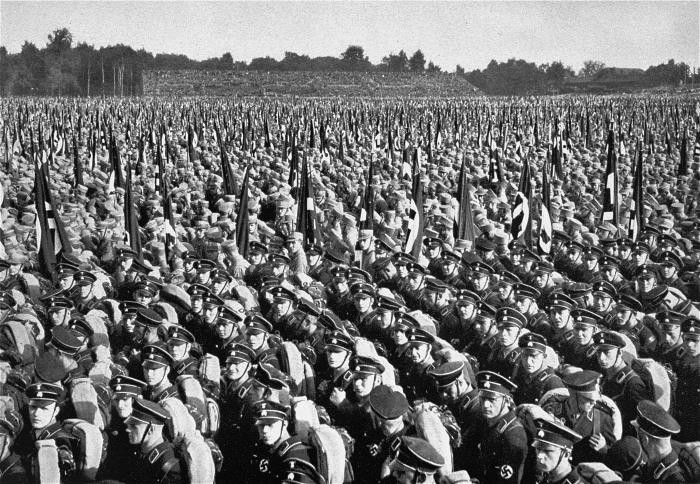
The SS
The SS (Schutzstaffel, or Protection Squads) was originally established as Adolf Hitler’s personal bodyguard unit. It would later become both the elite guard of the Nazi Reich and Hitler’s executive force prepared to carry out all security-related duties, without regard for legal restraint.
Key Facts
-
1
From the beginning of the Nazi regime, Hitler entrusted the SS first and foremost with the removal and eventual murder of political and so-called racial enemies of the regime.
-
2
The SS became a virtual state within a state in Nazi Germany, staffed by men who perceived themselves as the “racial elite” of the Nazi future.
-
3
The SS was specifically charged with the leadership of the “Final Solution,” the murder of European Jews.
From modest beginnings the SS (Schutzstaffel; Protection Squadrons), became a virtual state within a state in Nazi Germany, staffed by men who perceived themselves as the “racial elite” of Nazi future.
In the Nazi state, the SS assumed leading responsibility for security, identification of ethnicity, settlement and population policy, and intelligence collection and analysis. The SS controlled the German police forces and the concentration camp system. The SS conceived and implemented plans designed to restructure the ethnic composition of eastern Europe and the occupied Soviet Union.
From 1939, the SS assumed responsibility for “solving” the so-called Jewish Question; after 1941, its leadership planned, coordinated and directed the so-called Final Solution of the Jewish Question. This “solution” was the annihilation of the European Jews, which we now refer to as the Holocaust.
The SS before the Nazi Seizure of Power
In 1925, Adolf Hitler, the Führer of the National Socialist German Worker's Party (Nationalsozialistische Deutsche Arbeiterpartei-NSDAP), or Nazi party, established the SS. Subordinated to the chief of staff of the SA (Sturmabteilungen; Assault Detachments), the SS had the following duties: protecting Hitler and other Nazi leaders and speakers, providing security for political meetings, and soliciting subscribers to the Nazi party newspaper, Der Völkischer Beobachter (The Race-Conscious Observer).
In January 1929, at a time when the SS numbered 280 men, Hitler appointed Heinrich Himmler Reichsführer-SS (Reich Leader of the SS). Himmler saw an opportunity to develop an elite corps of the Nazi party based on race-nationalist (völkisch) visions of “racial purity,” and loyalty to Hitler as the personification of the future of the German nation. Through rigorous selection of candidates for entry into the SS on the basis of “racial” ancestry and political reliability, he transformed the SS into an elite guard composed of the best available German “racial material” with an absolute loyalty to Hitler's leadership of the Nazi movement and the German nation and Hitler's vision of the long-term future for the Third Reich.
Before the Nazis seized power in Germany, Himmler introduced two key functions to the SS: internal security and guardianship over racial purity. A few months after his SS crushed a revolt against Hitler's leadership by the Berlin SA, inspiring the SS motto, “My honor is loyalty,” Himmler created the Security Service (Sicherheitsdienst-SD) in the summer of 1931. The SD gathered intelligence on Hitler's opponents within the Nazi party, leaders and activities of other political parties, as well as on government officials, both federal and local. In August 1934, Nazi party deputy leader Rudolf Hess announced that the SD would henceforth be the only agency authorized to gather and analyze political intelligence in the Third Reich.
In late 1931, Himmler established a SS Race and Settlement Office (Rasse- und Siedlungsamt) to evaluate applications of SS men seeking to marry under a new internal “Marriage Decree.” This “expertise,” developed through maintaining “racial purity” in the SS, would later be utilized in wartime to determine whether an individual was “German” or not. Such a determination could, at a minimum, mean a job and better rations for a resident in German-occupied territory during World War II. For a Polish forced laborer in the Reich accused of having had sexual relations with a German woman, this “racial evaluation” could mean the difference between life and death.
The SS as Ideological Executive Force
When the Nazis seized power in January 1933, members of the SS numbered more than 52,000. As a reward for its role in murdering Ernst Röhm and the top leadership of the SA on June 30-July 2, 1934, Hitler announced that the SS was an independent organization. SS chief Himmler was now subordinate to Hitler in Hitler's new capacity as Führer (leader) of Germany. As Führer, Hitler was no longer a politician or chief executive bound by the legal constraints of the German State, but rather a symbol of Germany's future survival and greatness, with authority to act outside the laws of the state to guarantee Germany's survival and greatness. Himmler's subordination to Hitler within this “Führer-Executive” chain of command was the basis for the immense power that the SS accumulated during the Nazi regime.
As SS chief, Himmler received authority directly from Hitler to carry out ideological policies that the laws of the state might not permit. This ideologically-rooted “Führer authority” enabled authorization of indefinite incarceration in the concentration camp system and mass murder. Nazi leaders justified this extra-legal chain of command and the policies initiated under its authorization by the national emergency decrees following the Reichstag Fire in 1933 and, after 1939, by the intensified emergency created by the war.
Critical Thinking Questions
Research what pressures and motivations might have influenced members of the SS.
In what ways did the SS coordinate the activities of German and foreign police agencies to persecute perceived "enemies of the state"?

